This article needs additional citations for verification .(August 2018) |
The Asian Institute of Gemological Sciences (AIGS) is a private gemological school and gemological laboratory based in Bangkok, Thailand.
This article needs additional citations for verification .(August 2018) |
The Asian Institute of Gemological Sciences (AIGS) is a private gemological school and gemological laboratory based in Bangkok, Thailand.
The AIGS was founded in 1978 and was Thailand's first educational facility devoted to the study of gemstones. [1] The school and the laboratory are located in the Jewelry Trade Center, on Silom Road, in the heart of the gem and jewellery district of Bangkok. [2] [3] [4]
The AIGS school offers an Accredited Gemologist (A.G.) diploma (in Thai or English language) including "gemstone identification", "gemstone grading and pricing", "synthetics and treatments identification", and "diamonds". It also offers short courses such as introduction to gemology and jewelry design. With about 15,000 graduates from all over the world, it is one of the leading Gemological institutes in Southeast Asia.
The AIGS Gemological Laboratory was the first professional Gemological laboratory to be established in Asia (1978). It is a member of the Thai Gem and Jewelry Traders Association (TGJTA), and the International Colored Gemstone Association (ICA). The AIGS Gem Laboratory is very well known for its expertise in colored gemstones,[ citation needed ] especially ruby, sapphire, emerald, jade and rare stones, but it also provides identification and grading services for diamonds and jewelry.
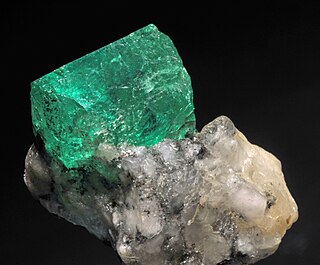
Emerald is a gemstone and a variety of the mineral beryl (Be3Al2(SiO3)6) colored green by trace amounts of chromium or sometimes vanadium. Beryl has a hardness of 7.5–8 on the Mohs scale. Most emeralds are highly included, so their toughness (resistance to breakage) is classified as generally poor. Emerald is a cyclosilicate.

A gemstone is a piece of mineral crystal which, in cut and polished form, is used to make jewelry or other adornments. However, certain rocks and occasionally organic materials that are not minerals are also used for jewelry and are therefore often considered to be gemstones as well. Most gemstones are hard, but some soft minerals are used in jewelry because of their luster or other physical properties that have aesthetic value. Rarity and notoriety are other characteristics that lend value to gemstones.

A ruby is a pink-ish red to blood-red colored gemstone, a variety of the mineral corundum. Ruby is one of the most popular traditional jewelry gems and is very durable. Other varieties of gem-quality corundum are called sapphires. Ruby is one of the traditional cardinal gems, alongside amethyst, sapphire, emerald, and diamond. The word ruby comes from ruber, Latin for red. The color of a ruby is due to the element chromium.
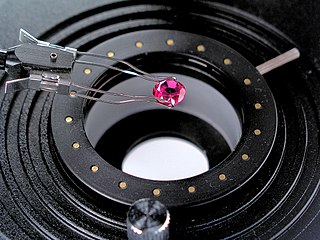
Gemology or gemmology is the science dealing with natural and artificial gemstone materials. It is a geoscience and a branch of mineralogy. Some jewelers are academically trained gemologists and are qualified to identify and evaluate gems.

Tanzanite is the blue and violet variety of the mineral zoisite, caused by small amounts of vanadium. Tanzanite belongs to the epidote mineral group. Tanzanite is only found in Tanzania, in a very small mining area near the Mererani Hills.
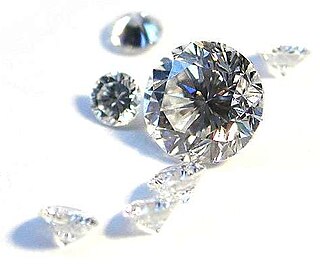
A chemically pure and structurally perfect diamond is perfectly transparent with no hue, or color. However, in reality almost no gem-sized natural diamonds are absolutely perfect. The color of a diamond may be affected by chemical impurities and/or structural defects in the crystal lattice. Depending on the hue and intensity of a diamond's coloration, a diamond's color can either detract from or enhance its value. For example, most white diamonds are discounted in price when more yellow hue is detectable, while intense pink diamonds or blue diamonds can be dramatically more valuable. Of all colored diamonds, red diamonds are the rarest. The Aurora Pyramid of Hope displays a spectacular array of naturally colored diamonds, including red diamonds.

The Gemological Institute of America (GIA) is a nonprofit institute dedicated to research and education in the field of gemology and the jewelry arts and based in Carlsbad, California. Founded in 1931, GIA's mission is to protect buyers and sellers of gemstones by setting and maintaining the standards used to evaluate gemstone quality. The institute does so through research, gem identification and diamond grading services and a variety of educational programs. Through its library and subject experts, GIA acts as a resource of gem and jewelry information for the trade, the public and media outlets.

Tairus is a synthetic gemstone manufacturer. It was formed in 1989 as part of Mikhail Gorbachev's perestroika initiative to establish a joint venture between the Russian Academy of Sciences and Tairus Created Gems Co Ltd. of Bangkok, Thailand. Today Tairus is a major supplier of hydrothermally grown gemstones to the jewellery industry. Later, Tairus became a privately held enterprise, operating out of its Bangkok distribution hub under the trade name Tairus, owned by Tairus Created Gems Co Ltd. of Bangkok, Thailand.

Gems & Gemology is a quarterly scientific journal published by the Gemological Institute of America. Each issue is devoted to research on diamonds, gemstones, and pearls. Topics include geographic sources, imitations and synthetics, treatments, and identification techniques. Established in January 1934, Gems & Gemology is geared toward jewelry professionals and gemologists.

The Jewelry Trade Center is a 59-story mixed-use skyscraper located in the Silom Road gemstone district of Bangkok, Thailand. Designed by Hellmuth, Obata and Kassabaum, the building was completed in 1996. At 220.7 metres (724 ft) it is currently the eighth-tallest building in Thailand. It was the tallest building in Thailand when it was completed.

Diamond is one of the best-known and most sought-after gemstones. They have been used as decorative items since ancient times.
International Gemological Institute (IGI) is a diamond, colored stone and jewelry certification organization. IGI is headquartered in Antwerp and has offices in New York City, Hong Kong, Mumbai, Bangkok, Tokyo, Dubai, Tel Aviv, Toronto, Los Angeles, Kolkata, New Delhi, Surat, Chennai, Thrissur, Ahmedabad, Shanghai, and Cavalese. Established in 1975, IGI is the largest independent gemological laboratory worldwide. It also runs Schools of Gemology in several locations around the globe.
The Swiss Gemmological Institute SSEF is a gemmology laboratory located in Basel, Switzerland. It is a part of the Schweizerische Stiftung für Edelstein Forschung. It was founded on an independent basis, by trade organisations, on August 22nd 1972. George Bosshart, mineralogist and GG was the first director after the laboratory's opening in Zürich. Diamond grading was the major task and colour stones were tested rather exceptionally. In 1980 Bosshart hired Dr. Henry A. Hänni, Mineralogist and FGA. In 1994 Hänni moved the laboratory to Basel. He has been teaching gemmology at Basel university, and the close link to the university proved to be very enriching for both parts, academic and laboratory work. Hänni became professor of gemmology at Basel University, also a reward for his years of steady research and supply of publications. Prof. H.A. Hänni retired in 2009 and Dr. Michael Krzemnicki took over his position as a director. Dr. Krzemnicki has been working for SSEF since 1999. SSEF has since long been offering its independent services to the global gemstone and jewellery trade. The mandate of the SSEF is to analyse precious stones and jewellery; issuing test reports for coloured gemstones, diamonds and pearls. Its forte lies in the detection of gemstone authenticity, origin, and gem treatments on a scientific and reproducible basis. It offers expert independent advice to a wide gemmological clientele including gem dealers, jewellers, auction houses and private customers in many countries. Gemmological training courses from basic to highly specialised are a further contribution to an international scholarship, ensuring a high level of gemmological knowledge and skills in the trade.
The gemstone irradiation is a process in which a gemstone is artificially irradiated in order to enhance its optical properties. High levels of ionizing radiation can change the atomic structure of the gemstone's crystal lattice, which in turn alters the optical properties within it. As a result, the gemstone's color may be significantly altered or the visibility of its inclusions may be lessened. The process, widely practised in jewelry industry, is done in either a nuclear reactor for neutron bombardment, a particle accelerator for electron bombardment, or a gamma ray facility using the radioactive isotope cobalt-60. Irradiation has enabled the creation of gemstone colors that do not exist or are extremely rare in nature.
Richard T. Liddicoat, Jr. was an American gemologist. Liddicoat was an educator in gemology, who also made contributions in the area of diamond quality grading and gem identification. Liddicoat was the Chairman of the Board of Governors at Gemological Institute of America (GIA).
Universal Gemological Laboratories (GCI) is a modern gemological laboratory and a college for educational services founded in 1998. The laboratory's main headquarters is in the Israel Diamond Exchange in Ramat Gan. The GCI has regional labs and educational centers equipped with local and Israeli staff in Russia and since June 2006 in India—a disposition of four branches in Mumbai, Delhi, Hyderabad and Kolkata. GCI is the only western lab that is official permitted by the Russian government to operate in Russia.
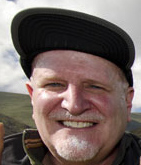
Richard W. Hughes is an American gemologist and author, known as an authority on corundum, rubies and sapphires.
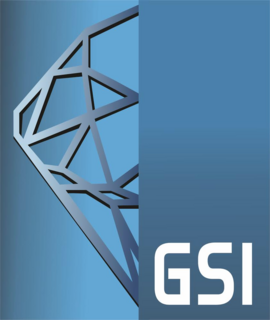
Gemological Science International, or GSI, is an independent gemological organization that is one of the largest gemological entities in the world, with offices in four continents.
Henry Ho is a jeweler in Thailand and President of the Bangkok Diamond & Precious Stones Exchange.

Lotus Gemology is a gemology laboratory located in Bangkok, Thailand. It was founded in 2014 by Richard W. Hughes & Wimon Manorotkul and their daughter, E. Billie Hughes. Their idea was that, while precious stones were articles of great beauty, the lab reports issued by gem labs better resembled blood tests from a doctor than a celebration of that beauty. Thus they set about creating lab reports that were both scientifically accurate and aesthetically beautiful. Lotus Gemology's lab report covers are color coded. Gold reports are reserved for gems that are completely untreated, while silver reports are for gems that have been subjected to industry-standard treatments. Black reports are reserved for heavily treated and man-made gems. This consumer-friendly approach is unique in the industry.
AIGS, the oldest professional gemological laboratory established in 1978, has warned the trade over fake reports of the gemstones.